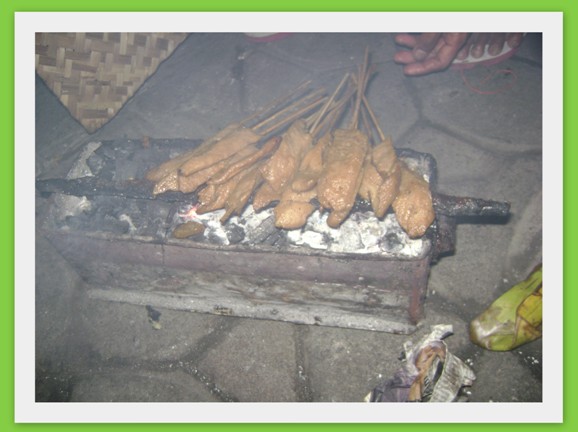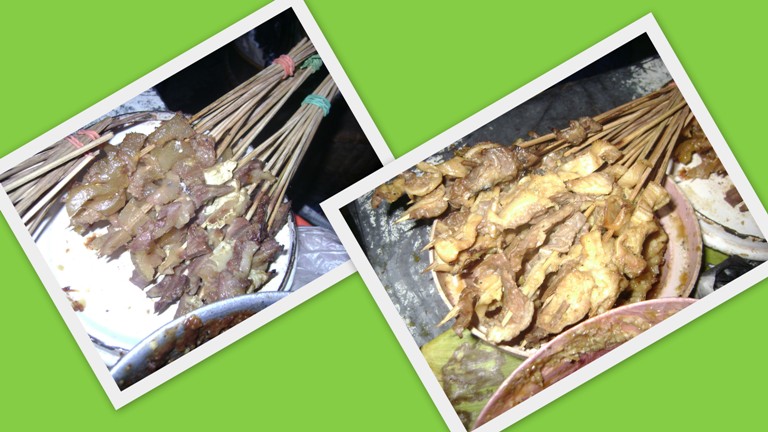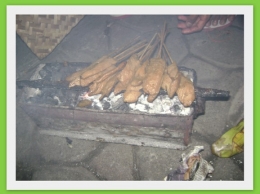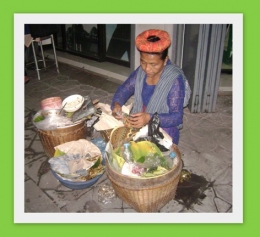Sate kere, cheap and simple, so is it only for the poor? Photo by Sonny Hendrawan Saputra.
In delivering his speech during his visit in Indonesia, US President, Barack Obama shared his little memory during his childhood time in Indonesia. He remembered about satay, the typical menu of Indonesian people. Audiences became to laugh when he imitated the voice of satay pitchman...."teeeee....saa.....teee....". His memory and longing about satay in Indonesia was finally recovered when he could enjoy it during state banquet with Indonesia President, Susilo Bambang Yudhoyono. Yes, Obama loves satay as most other Indonesian people. For foreigners, including Obama, the image of satay is strongly attached to Indonesian culinary life. Indonesian students who study in other countries often deliver satay as the menu during International cultural and food festival. Though satay is very famous and has variation in ingredients and spices to make it, what the people have in mind at first place is chicken satay (sate ayam) and some others are familiar with goat satay (sate kambing). In fact, Indonesia has so many variations of it including kere satay (sate kere), the traditional menu from Solo city.
What is sate kere? From the name of satay which is always together with the animal like chicken and goat, you probably have questions "Is kere kind of animal?", "If it is animal, is it kind of bird or mammal?" Well, before going to further imagination of what kind of animal it is, let me open you Javanese dictionary. Kere simply means poor. Javanese commonly used this word for addressing to people who are inferior in finance. So why can it become the name of satay? In the past, many people could not afford to buy chicken satay due to the economic condition. Since they want to enjoy the pleasure of eating it, they have creativity to cook the food with cheap budget having similar style like delivering satay plus it uses sauce which is just the same with sauce in chicken satay. That's why people began to call it as sate kere; the kere satay, the satay which could be afforded by the poor.

The main composition of it is gembus: soybean dreags as the remain from tofu (tahu) making process. That's why the cost of it can be very low and make the price to sell become very cheap. Since there is no meat, vegetarians can also enjoy it even they can have similar experience like eating meat - it can be solution of menu variations for vegetarians. Gembus is grilled in fired wooden charcoal which is commonly called by Indonesians as arang. Just in several minutes, the dish is ready. Then, sate kere is poured with peanut sauce which has strong sweet taste from palm sugar. To make it more exotic in taste, you can ask the seller to put slices of chillies and onions.
When you come or stay in kampongs along Solo, you probably can meet the ladies who sell sate kere door to door with traditional modest Javanese cloth. You can also find them by sudden on the main street, when they walk passing it. Most of them are still very traditional in making, performing, and delivering sate kere. In fact, that makes sate kere more interesting for tourists.

Back to my title, is sate kere only for the poor because it has no meat, cheap, and simple? Off course not, though it can be considered as "people's food" because of its simplicity especially in economics side, people from various classes love it. Now, people can also find sate kere in street stall which has better style in performance; it is similar to restaurant. Even most of them now add satays from beef offals including lever and intestine which are off course more expensive sate kere from gembus.

With only IDR 3,000 (from traditional seller) - 7,500 (from street seller similar to restaurant), you can enjoy this sate. You can add ketupat or lontong (rice which is covered by young coconut leave before boiled) to make you more full. Since it is cheap and not fatty, you can eat it a lot and don't worry, you will not be kere because of it.










